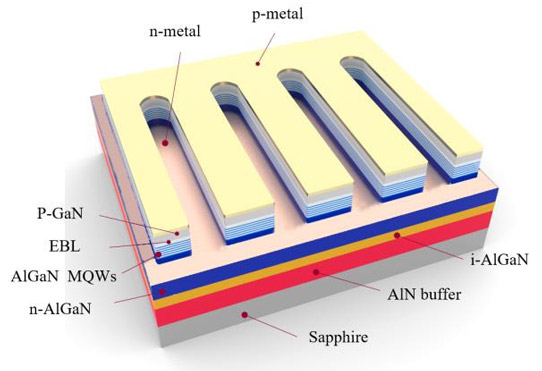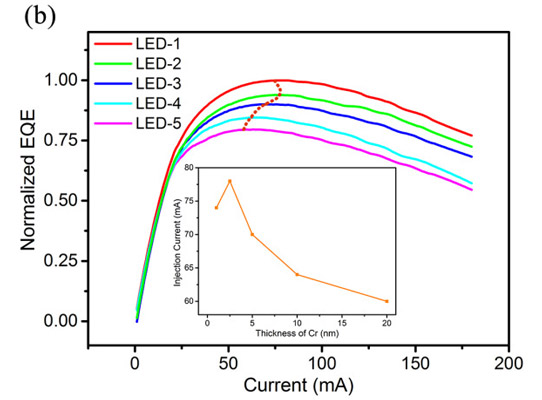- News
20 June 2019
Chromium/aluminium n-electrode for reflection boost of deep-ultraviolet LEDs
Researchers based in China have been applying reflective n-type electrode metal structures to boost light extraction in 280nm-wavelength deep-ultraviolet light-emitting diodes (DUV-LEDs) [Yang Gao et al, IEEE Transactions on Electron Devices, published online 21 May 2019]. One of the big challenges for sub-300nm DUV devices is pushing the efficiency above 10%.
The work by Huazhong University of Science and Technology and University of Science and Technology of China used a chromium/aluminium combination to enhance reflection of the electrodes on the n-type aluminium gallium nitride (AlGaN) contact layer of the LEDs. While the chromium absorbs DUV radiation, aluminium is highly reflective.
The researchers explain the need for chromium in the electrode: “If we only adopt the Al layer as the n-type electrode, it is almost impossible to form an ohmic contact with the Al-rich n-AlGaN. Therefore, a Cr metal layer must be introduced before the deposition of the Al layer to form an ohmic contact and improve the electrical performance.”
The researchers see DUV applications in sterilization, water/air purification, medical and bio-related equipment. Competing mercury-lamp devices have drawbacks such as system fragility and bulk, along with short lifetime and low efficiency. And, of course, mercury is highly toxic.
The DUV-LED material was grown by metal-organic chemical vapor deposition (MOCVD) on c-plane sapphire. The buffer consisted of 2μm of AlN. Undoped Al0.55Ga0.45N was used for strain release before a silicon-doped n-Al0.55Ga0.45N contact layer. The light-emitting active region contained five 2.5nm Al0.37Ga0.63N quantum wells separated by 12.5nm Al0.51Ga0.49N barriers. The p-side of the device consisted of magnesium-doped p-Al0.7Ga0.3N and p-GaN contact layers.

Figure 1: Schematic of flip-chip DUV-LED device.
The fabrication process was designed to create flip-chips with the DUV light emerging mainly through the sapphire substrate since the bandgap of p-GaN is less than that of the photon energy (Figure 1). The relatively narrow p-GaN gap makes it highly absorbing of the DUV. Unfortunately, magnesium-doping of high-Al-content AlGaN results in very low enhancement of the hole concentration at room temperature due to a high activation energy.
DUV-LED fabrication began with inductively coupled plasma etch to expose the n-AlGaN contact layer. The reflective n-electrode consisted of chromium/aluminium/titanium/gold (Cr/Al/Ti/Au) deposited by electron-beam evaporation. The thicknesses of the aluminium, titanium and gold layers were 120nm, 40nm and 60nm, respectively. The chromium thickness varied between 1nm and 20nm. The n-electrode was annealed at 850°C for 30 seconds in nitrogen. The p-electrode consisted of nickel/gold/nickel/gold.
An LED with 2.5nm chromium in the n-contact had the lowest turn-on voltage of 4.7V (LED-2). The same device also had the lowest contact resistance. The ideality factor of the devices was around 5.31.

Figure 2: (a) LOP versus injected current for five fabricated DUV-LED devices. (b) EQE in terms of current. Inset: corresponding injection current to achieve peak EQE. LED-3 and LED-4 had 5nm and 10nm Cr, respectively.
In terms of light output power (LOP) at a given current injection, the device with 1nm chromium in the reflector (LED-1) gave the highest value (Figure 2). At 180mA injection, the output power was 40.9% higher than that for the LED with the thickest chromium layer – LED-5 with 20nm Cr. The researchers suggest that the higher turn-on voltage and contact resistance of LED-1 versus LED-2 could be due to the chromium layer being too thin to form the high-quality Al-Cr and Cr-N alloys needed for ohmic contact. The higher light output is attributed to the high reflectivity of the aluminium layer.
The peak external quantum efficiency (EQE) for LED-1 was 25.4% greater than that of LED-5. The corresponding figure for LED-2 was 17.9%. The current injection point of the peak efficiency varied with device: 74mA for LED-1, 78mA for LED-2, and 60mA for LED-5. The researchers explain the higher current injection for LED-2 as being due to its superior ohmic contact and electrical behavior. “Normally, a lower contact resistance or better ohmic contact can definitely improve current spreading and thus higher current injection efficiency,” the team writes.
The reflectivity of Cr/Al metal stacks on sapphire was measured at 280nm center wavelength and compared with the results from an unalloyed Al layer. The relative reflection for 1nm Cr was 93.1%, and that for 2.5nm Cr was 82.2%.
DUV LEDs Chromium/aluminium n-electrode AlGaN MOCVD
https://doi.org/10.1109/TED.2019.2914487
The author Mike Cooke is a freelance technology journalist who has worked in the semiconductor and advanced technology sectors since 1997.


